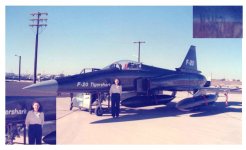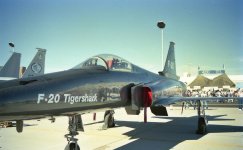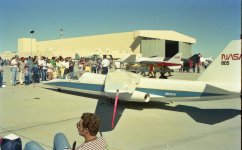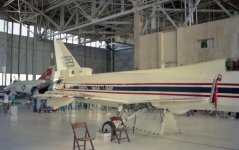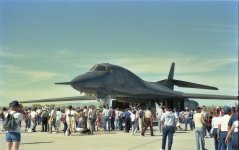This is a photo of my Wife standing next to the sole surviving F20 Tigershark Prototype at Edwards AFB in 1985. The upper right inset photo is of the "N" Number: N44671, the lettering was only a few shades different from the plane body paint.
On this day this Tigershark was flown for a private viewing of military brass and some dignitaries. I believe it was flown by Chuck Yeager for this presentation.
The F20 Tigershark Program is very unusual in that it was Totally Funded with Private Funding.
There were 3 F20 Prototypes produced. 2 Crashed with the loss of the pilots the third is on display at The California Science Center in LA. The F20 never went into production.
An actual F20 was never seen by the public that I know of. Only photographs were made available.
************************************************
Sorry I did not mention this in the original posting, did't think it was of value to the jest of the posting.
My Wife was married to her prior husband while at Edwards who was a Master Sergeant and was responsible for electronics and autopilots for prototype and upgraded aircraft.
He worked with Fairchild on the T46 project side by side seated trainer. He worked with Boeing on electronic modifications and upgrades to the C-130 Gunship. He was hired by Boeing when he retired. He passed away from cancer a few years later.
She believes he also worked on the F20 while it was at Edwards.
She said he assisted with emergency electronic repairs on a SR-71 Blackbird at Edwards, has photos of him with the Blackbird in the hanger.
On this day this Tigershark was flown for a private viewing of military brass and some dignitaries. I believe it was flown by Chuck Yeager for this presentation.
The F20 Tigershark Program is very unusual in that it was Totally Funded with Private Funding.
There were 3 F20 Prototypes produced. 2 Crashed with the loss of the pilots the third is on display at The California Science Center in LA. The F20 never went into production.
An actual F20 was never seen by the public that I know of. Only photographs were made available.
************************************************
Sorry I did not mention this in the original posting, did't think it was of value to the jest of the posting.
My Wife was married to her prior husband while at Edwards who was a Master Sergeant and was responsible for electronics and autopilots for prototype and upgraded aircraft.
He worked with Fairchild on the T46 project side by side seated trainer. He worked with Boeing on electronic modifications and upgrades to the C-130 Gunship. He was hired by Boeing when he retired. He passed away from cancer a few years later.
She believes he also worked on the F20 while it was at Edwards.
She said he assisted with emergency electronic repairs on a SR-71 Blackbird at Edwards, has photos of him with the Blackbird in the hanger.
Attachments
Last edited:

